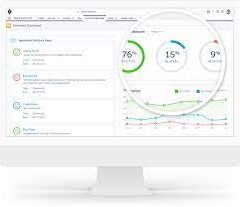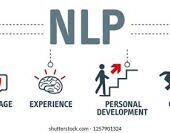Harnessing the Power of AI for Business Transformation
The age of artificial intelligence (AI) is here. How to Implement AI for Business Transformation? Once a niche technology confined to research labs and the realm of science fiction, AI has now become a mainstream force. Today, an estimated 35% of businesses are leveraging AI to enhance products, boost efficiency, and gain a competitive edge. However, for companies yet to begin their AI journey, the path to implementation can seem daunting. So how can organizations navigate the complexities of AI and unlock its potential to drive success?
This comprehensive guide is designed to empower businesses to confidently adopt AI. We’ll break down what AI is, assess your organization’s readiness, help you develop a robust AI strategy, and explore how to implement and integrate AI across operations. Ultimately, this insight will show you how to embrace AI for continuous innovation, helping automate tasks, uncover insights, and future-proof your business.
AI Era Demands an Intelligent Data Infrastructure AI consulting services and digital transformation partners like Tectonic underscore the technology’s immense value, helping organizations evaluate, implement, and scale AI initiatives. However, knowing where to start and who to trust can be challenging. This guide will provide best practices for planning and executing AI projects, helping you make informed decisions when selecting solutions and partners.
By the end, your organization will be equipped with the knowledge and confidence needed to make AI a powerful competitive advantage.
Understanding the AI Landscape
Before diving into AI implementation, it’s important to understand what artificial intelligence is and the wide array of applications it offers.
What is Artificial Intelligence?
Artificial intelligence (AI) refers to software and machines designed to perform tasks that typically require human intelligence—such as visual perception, speech recognition, decision-making, and language translation.
AI is already deeply integrated into many everyday products and services, including:
- Personal assistants like Siri, Alexa, and Google Assistant
- Recommendation algorithms on platforms like Netflix and Amazon
- Self-driving technology in cars
- Machine translations in services like Google Translate
Machine Learning Basics
At the core of most AI systems is machine learning (ML), which involves training algorithms on vast datasets, enabling them to learn from examples without being explicitly programmed for every scenario.
There are three main types of machine learning:
- Supervised learning: The algorithm is trained on labeled data to map input-output relationships and make predictions on new, unlabeled data.
- Unsupervised learning: The algorithm finds patterns and insights from unlabeled data, such as clustering customers based on behavior.
- Reinforcement learning: The algorithm learns by interacting with its environment, making decisions to maximize rewards, commonly used in game-playing AI.
Beyond ML, fields like natural language processing (NLP) focus on understanding human language, while computer vision analyzes visual content such as images and video.
Real-World AI Applications
Understanding the fundamentals of AI helps organizations align their needs with its capabilities. Common business use cases for AI include:
- Chatbots & Virtual Assistants: Automate customer service or provide intelligent assistance for employees.
- Predictive Analytics: Forecast trends to inform strategic decisions.
- Anomaly Detection: Identify outliers in data that may signal security threats or fraud risks.
- Computer Vision: Power applications like medical imaging or manufacturing quality control by extracting insights from visual data.
Armed with this knowledge, businesses can better evaluate how AI fits into their goals and operations.
Developing a Comprehensive AI Strategy
Once you understand the AI landscape, the next step is developing a strategic plan to guide implementation.
Establishing an AI Vision and Objectives
AI adoption must align with clear financial and operational goals. Leadership teams should identify:
- The key business challenges AI will address
- Success metrics and KPIs for the next 1-3 years
- Benchmarks for measuring the impact of AI initiatives
Aligning stakeholders and executive leaders around specific use cases will drive urgency, investment, and commitment.
AI Ethics and Governance
AI adoption also requires guidelines for ethical usage, transparency, and accountability. Organizations should consider:
- Which tasks are appropriate for automation versus requiring human oversight
- How to mitigate biases in training data or algorithms
- Policies for data privacy, security, and AI accountability
Establishing these frameworks early ensures responsible and transparent AI usage.
Resourcing an AI Program
AI implementation requires the right talent and resources. Budget considerations should include:
- Cloud infrastructure and data engineering
- Tools for model development and operations (MLOps)
- External partnerships or consultants to fill gaps in expertise
A Phased AI Adoption Roadmap
Rather than attempting to scale AI all at once, organizations should adopt a phased approach:
- Proof of Concept: Test feasibility with minimal data and models (3-6 months).
- Pilots: Deploy AI at small scale to enhance specific processes (6-12 months).
- Scaling: Industrialize AI pipelines and models (12-18 months).
- Expansion: Apply AI to additional business units (18-24 months).
This roadmap balances short-term impact with long-term scalability.
Choosing the Right AI Implementation Approach
With your strategy in place, the next decision is how to implement AI. Three primary approaches are:
- Building In-House: This allows for full customization but requires significant internal expertise and resources.
- Leveraging AI SaaS Solutions: Turnkey solutions offer faster implementation but less flexibility.
- Partnering with AI Experts: External consultants bring domain expertise and can accelerate AI adoption with customized solutions.
The choice depends on your organization’s internal capabilities, desired level of customization, and timeline.
Integrating AI into Your Operations
Successful AI implementation requires careful planning and integration with existing operations.
Develop an Integration Plan
Consider how AI will interact with existing systems and workflows:
- What data inputs are needed?
- How will AI outputs be integrated into decision-making processes?
- What new user interfaces or reports are required?
Address Security and Privacy
Ensure that AI systems comply with data privacy regulations and security protocols, especially when handling sensitive information.
Drive Adoption Through Training
Help staff understand how AI will augment their roles by providing training on how the algorithms work and how to interact with AI systems effectively.
Monitor for Model Decay
Implement processes to monitor and retrain models as needed to ensure continued performance and reliability.
Embracing AI for Continuous Improvement
AI should be viewed as an ongoing investment, driving continuous improvement across the organization.
Encourage a Data-Driven Culture
Empower teams to identify new AI use cases and experiment with AI-driven solutions. Provide the tools and frameworks to facilitate this culture of innovation.
Foster Responsible AI
Ensure that AI systems are transparent, accountable, and designed to augment human decision-making responsibly.
Commit to Reskilling
As AI capabilities evolve, continually upskill employees to ensure your workforce remains at the forefront of technological advancements.
Unlocking the Future of AI
The potential of AI to revolutionize businesses is clear. However, achieving success requires more than just technical capabilities. It demands thoughtful planning, strategic alignment, and a commitment to continuous improvement.
By following this guide, your organization can confidently implement AI to unlock powerful data-driven insights, automate tasks, and achieve lasting competitive advantage. The future of AI is full of possibilities—are you ready to seize them? Tectonic is ready to help.
How to Implement AI for Business Transformation













